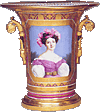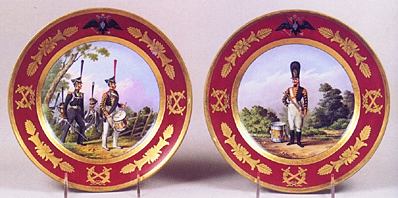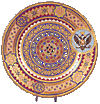

From the Period of Alexander I
Cachepot. 1815-1825. Porcelain, overglaze decoration, gilding. Height 29.1
cm. (11 1/2 in.).

From Her Majesty's Own Dinner Service, made for Empress Elizabeth (1741-1762)
additions to the service dating from 1825-1855.
|


above: Two Military Plates. Circa 1816. Porcelain, overglaze
polychrome decoration, gilding. Diameter 24.2 cm. (9 1/2 in.).
AN IMPERIAL FASCINATION
Since we opened our first shop in New York almost sixty years
ago, we have had exhibits devoted to Fabergé, gold boxes, antique jewelry,
automatons, and Russian icons, all areas of special interest to us. Although we
maintained a permanent collection of Russian Porcelain, it was neither large enough
nor broad enough to mount an exhibition, even with the inclusion of material available
in the West. With the offer of a loan from Peterhof, however, this exhibition
detailing the grandeur and beauty of life in the palaces of Imperial Russia was
made possible.
The making of porcelain in Russia began with Peter the Great (1687-1725),
as seen in the tiled walls of Monplaisir . In his quest to unite, educate and
develop trade for Russia, he engaged artisans from around the world and invited
many different European craftsmen to live and work in Russia. Peter's desire to
establish Russia as a European power, and Elizabeth's and Catherine's continuing
interest in westernization, required the establishment of an imperial porcelain
factory, such as was the fashion in the courts of Europe. In fact, the Russian
word for porcelain, "farfor," derives from the Arabic and Persian "Fakhfur," meaning
"imperial, " which in turn derives from the name of a Chinese Emperor after whom
an area for the manufacture of porcelain was named.
When Peter's daughter, Elizabeth, became Empress (1741-1762), she continued
to search for qualified artisans and eventually hired Chistoph Konrad Hunger to
establish a porcelain factory in St. Petersburg. He was, unfortunately, an adventurer
who had little success with the factory, and true porcelain in Russia was developed
by his assistant, Dmitri Vinogradov.
More than many other European porcelain factories, however, the Russian Imperial
Factory was dependent on foreign craftsmen and ideas. The early Germanic influence
on production during the Elizabeth period gave way to French influence, which
dominated not only the Imperial Factory, but influenced several private factories
as well. The overall direction of the Imperial Factory was, however, Russian,
and came under the financial and artistic jurisdiction of His Majesty's Cabinet
(the Imperial chancellor), which, after 1802, also ran the imperial glass and
tapestry factories.
The private factories of Russia, the most famous of which was that of Francis
Gardner of Moscow, which has imperial patronage, benefited greatly when, in 1806,
a new law preventing the importation of commercial porcelain was passed to protect
the attempted sale of some of the imperial wares. Much of its output equalled
that of the Imperial facory in quality, which is why they are represented in this
online exhibition.
Paul Schaffer, President
A La Vieille Russie
|
|


Kornilov Brothers Factory, circa 1885.
Gilded, varicolored porcelain plate with an Imperial eagle.

From the period of Alexander I
Plate. Porcelain, overglaze polychrome decoration, gilding. Diameter 24.7 cm.
(9 3/4 in.).
|